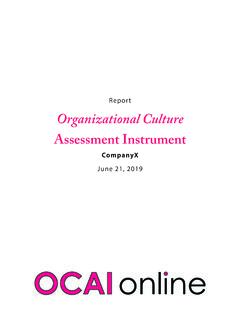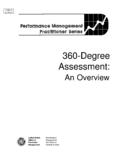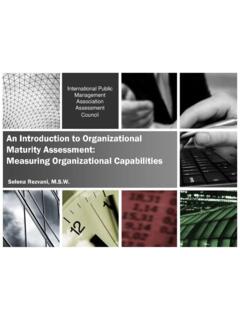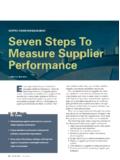Transcription of Organizational Culture Assessment Instrument - OCAI online
1 Organizational Culture Assessment InstrumentTheory and Toolplus the OCAI online products and services2 | OCAI onlineContentsWhy work with Culture ? 3 The Competing Values Framework 4 The Organizational Culture Types 5 The OCAI Assessment 7 The Culture Change Process 9 OCAI online products and services 12 Marcella Bremer3 | OCAI onlineWhy work with Culture ?Why do organizations invest in Organizational Culture ?
2 Culture influences Organizational performance, innovation, agility, engagement, recruitment and retention, and competitiveness. Kotter and Heskett found that effective Culture can account for 20-30 percent of the differential in corporate performance when compared with culturally unremarkable Kim Cameron showed that a positive climate, positive rela-tionships, communication, and positive meaning lead to positive deviance or high performance. Christine Porath and Christine Pearson did a study with 14,000 respondents and found that incivility demoralizes people. The estimated loss of productivity per year per employee is $ 14,000 on average. Bill Sutton (Stanford University) has suggested that productivity could decrease by 40% when workers experience : a toxic Culture decreases productivity with 40%, incivility as part of Culture damages productivity with $14,000 per employee per year, while an effective Culture increases productivity with 20%, and a positive Culture boosts results by 30-40% Culture is also often the reason why 70 percent of all mergers, acquisitions and Organizational change projects , Culture is not as soft as prejudice would have it.
3 It produces hard Organizational Culture Assessment Instrument (OCAI, Kim Cameron) is a validated tool for assessing Organizational Culture , developed by Robert Quinn and Kim Cameron at the University of Michigan. As people are often not aware of the Culture , the OCAI helps people and organizations notice their current Culture and see what they would OCAI survey is based on the Competing Values Framework: one of the most used and useful frameworks; by over 10,000 companies in 30 years (ten Have, 2003). I want to pass on my personal thanks for your speedy and highly professional analysis of my surveys. Dr. Brian Armstrong, Co-Director of Unscheduled & Acute Care, Belfast Health & Social Care Trust4 | OCAI onlineIt is well-researched and validated, but also compact with six aspects that reliably represent an organization s Culture .
4 It s a quick Culture survey that can be done in 15-20 minutes online , in 19 different languages. Let s look at its theory Competing Values FrameworkThe Competing Values Framework (CVF) emerged from research to identify the Organizational effectiveness criteria (Quinn & Rohrbaugh, 1981). The criteria that were found to make a difference are the dimensions internal-external, and organization might have an internal orientation; focusing inward on development, collaboration, integration of activities, coordination. Or it might have an external orientation; looking at the market, what s possible with the latest technology, what competitors are doing, what customers want, and it could diversify activities as a result.
5 Both internal and external attention is needed to be successful in the long run - but depending on their environment an organization will have a dominant preference. An agile, volatile market calls for an external orientation whereas a stable environment allows an internal the competing nature of the values: you have to choose whether you look inside or outside - you cannot do both at the same second defining dimension is the focus on stability or flexibility organizations that prefer to organize for stability value clear structures, planning, budgets, and reliability. They assume that reality can be known and controlled. Organizations that organize with flexibility assume the opposite: you can never predict and control everything.
6 They prefer a flexible attitude and organization to adapt quickly to changing circumstances - focusing more on people and activities than on structure, procedures, and plans. The competing values nature of stability and flexibility prevents you from doing both at the same time. Organizations can spend their money, attention, and time only once, so they tend to emphasize certain values. Quinn and Cameron found that flexible organizations are most effective, which sometimes leads to contradictory behavior. The best organizations use all four value sets when Culture type works best in the activities domain that aligns with its values. In the health care sector, for instance, we often see Collaborate or Clan Culture .
7 5 | OCAI onlineBeware: there is no ultimate best Organizational Culture prescribed by the Competing Values Framework. The model is descriptive - not normative. In a specific domain or market, one Culture type might fit better than another, and this is for the organization to decide. When would be at our best? When you map those two polarities in a 2x2 matrix, you see four Culture types emerge:The Competing Values Framework is validated by a lot of research (Denison, 1990; Howard, 1998; Deshpande & Farley, 2004). It is aligned with other dimensions that describe how people behave when organizing (Linnenluecke, 2010; Ralston, Tong, Terpstra, Wang & Egri, 2006; Cameron & Quinn, 2006).
8 These underlying dimensions of organizing exist in all human and Organizational activity. It aligns with the four biological determined drives in the brain: the need to bond, to learn, to acquire, and to defend. (Paul Lawrence, Nitin Nohria, 2002). The CVF and OCAI can also be related to the Big Five personality traits, the MBTI, and the four psychological types discovered by Carl Gustav of this conceptual arche-typical basis, the Competing Values Framework can integrate many other tools on leadership and scientific basis is excellent but what is best is its practical applicability. The CVF helps you see what people value and emphasize when they organize activities, whether they are in a for-profit organization, a sports club, local community, or a family.
9 The framework shows where you are and where you d like to go. The usefulness of the OCAI and the ease with which our clients can understand the data makes this a perfect Instrument to use. The vendor is super-responsive. I love using this Instrument and appreciate all the care we are given. Judith Schechtman, Senior Consultant, Triangle Associates, USACVFI nternal orientationExternal orientationFlexibilityCollaborate or Clan CultureCreate or Adhocracy CultureStabilityControl or Hierarchy CultureCompete or Market Culture6 | OCAI onlineThe Organizational Culture TypesMapping those two dimensions of competing values you get four Culture types: the dynamic, entrepreneurial Create Culture , the peo-ple-oriented, friendly Collaborate Culture , the process-oriented, structured Control Culture and the results-oriented, competitive Compete Culture .
10 Also known as Adhocracy, Clan, Hierarchy and Market Culture (Cameron & Quinn). Create Culture (Adhocracy Culture )This is a dynamic and creative working environment. Employees take risks. Leaders are seen as innovators and risk takers. Experiments and innovation are a way of bonding. Prominence is emphasized. The long-term goal is to grow and create new resources. The availability of new products or services is seen as a success. The organization promotes individual initiative and freedom. Do new things: create, innovate, envision the future Transformational Change Handle discontinuity, change, and risk Freedom of thought and action, rule-breaking Thoughtful experimentation, learning from mistakes, failing fast Roles like entrepreneurs and visionaries Visionaries inclined toward risk, not afraid of uncertaintyTypical in sectors like technical start-ups, technology-driven industries (communications, sustainability), but also disruptive services like Airbnb, Culture (Clan Culture )This working environment is friendly.








